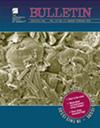FTIR study of H2O in silicate minerals and mineral inclusions in chromite from the peridotite zone of the Stillwater complex (Montana, USA): Evidence for chromitite formation in an H2O-rich environment
IF 3.9
1区 地球科学
Q1 GEOSCIENCES, MULTIDISCIPLINARY
引用次数: 1
Abstract
Although the involvement of hydrous fluids has been frequently invoked in the formation of stratiform chromitites in layered intrusions, there is a lack of natural evidence to signify their presence and mechanism. Here, Fourier-transform infrared spectroscopy (FTIR) of H2O in silicate minerals in the lowermost layer and G chromitite layer of the Stillwater complex, Montana, USA, shows that olivine grains have 20−55 ppm H2O, orthopyroxene has 30−45 ppm H2O, and clinopyroxene has 144−489 ppm H2O. The jointly increasing H2O contents of olivine and orthopyroxene in silicate cumulates along with magma differentiation record a negative correlation in chromitites. On the basis of poikilitic clinopyroxene, we calculated that the interstitial melts had averages of 1.3 wt% and 2.3 wt% H2O in dunite and chromitite, respectively, showing significant differences between chromitites and silicate cumulates. More than 10% of the chromite grains contained polymineralic inclusions up to 100 μm in size that were composed mainly of orthopyroxene, hornblende, plagioclase, and phlogopite. Most of these minerals were characterized by higher MgO and fluid-mobile element contents, such as Na and K, than minerals in associated silicates. Based on the mineral modes of the hydrous phases and their compositions, the trapped fluids contained ∼2.6 wt% H2O, consistent with the FTIR estimates, indicating the inclusion compositions represent interstitial melts instead of parental magmas. These observations indicate that the chromite microlites collected fluids during early crystallization, leading to a heterogeneous fluid redistribution in the melt. The fluids were collected on the surface of chromite grains during crystallization and then dissolved into poikilitic pyroxene. Chromite grains could also be efficiently floated by these fluids, causing them to migrate away from the silicate minerals in the magma channel and leading to the formation of nearly monomineralic chromitite seams. This process serves as a kinetic model indicating that chromite could be completely separated from silicates during mechanical sorting in layered intrusions.美国蒙大拿州斯蒂尔沃特杂岩橄榄岩带硅酸盐矿物和铬铁矿矿物包裹体中H2O的FTIR研究:铬铁矿在富水环境中形成的证据
尽管含水流体的参与经常被用于层状侵入体中层状铬铁矿的形成,但缺乏表明其存在和机制的自然证据。在这里,美国蒙大拿州斯蒂尔沃特杂岩最下层和G铬铁矿层硅酸盐矿物中H2O的傅立叶变换红外光谱(FTIR)显示,橄榄石颗粒具有20−55 ppm H2O,斜方辉石具有30−45 ppm H2O,斜辉石具有144−489 ppm H2O。硅酸盐堆积体中橄榄石和斜方辉石的H2O含量随着岩浆分化而共同增加,铬铁矿中的H2O含量呈负相关。在异辉橄榄斜辉石的基础上,我们计算出纯橄榄岩和铬铁矿中间隙熔体的平均H2O分别为1.3wt%和2.3wt%,表明铬铁矿和硅酸盐堆积体之间存在显著差异。超过10%的铬铁矿颗粒含有大小达100μm的多矿物包裹体,主要由斜方辉石、角闪石、斜长石和金云母组成。这些矿物中的大多数具有比伴生硅酸盐中的矿物更高的MgO和流体流动元素含量,如Na和K。根据含水相的矿物模式及其成分,捕获的流体含有~2.6wt%的H2O,与FTIR估计一致,表明包裹体成分代表间隙熔体,而不是母岩浆。这些观察结果表明,铬铁矿微晶在早期结晶过程中收集了流体,导致熔体中的不均匀流体重新分布。在结晶过程中,流体被收集在铬铁矿颗粒的表面,然后溶解为异辉橄榄辉石。铬铁矿颗粒也可以被这些流体有效地漂浮,导致它们从岩浆通道中的硅酸盐矿物中迁移出来,并导致形成几乎单矿物的铬铁矿矿层。这一过程是一个动力学模型,表明在层状侵入体的机械分选过程中,铬铁矿可以与硅酸盐完全分离。
本文章由计算机程序翻译,如有差异,请以英文原文为准。
求助全文
约1分钟内获得全文
求助全文
来源期刊

Geological Society of America Bulletin
地学-地球科学综合
CiteScore
9.30
自引率
8.20%
发文量
159
审稿时长
4-8 weeks
期刊介绍:
The GSA Bulletin is the Society''s premier scholarly journal, published continuously since 1890. Its first editor was William John (WJ) McGee, who was responsible for establishing much of its original style and format. Fully refereed, each bimonthly issue includes 16-20 papers focusing on the most definitive, timely, and classic-style research in all earth-science disciplines. The Bulletin welcomes most contributions that are data-rich, mature studies of broad interest (i.e., of interest to more than one sub-discipline of earth science) and of lasting, archival quality. These include (but are not limited to) studies related to tectonics, structural geology, geochemistry, geophysics, hydrogeology, marine geology, paleoclimatology, planetary geology, quaternary geology/geomorphology, sedimentary geology, stratigraphy, and volcanology. The journal is committed to further developing both the scope of its content and its international profile so that it publishes the most current earth science research that will be of wide interest to geoscientists.
 求助内容:
求助内容: 应助结果提醒方式:
应助结果提醒方式:


